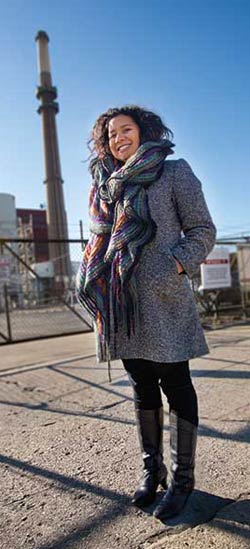
Photo: Bob Stefko
It’s an early November morning in a crowded Starbucks in Chicago’s Loop, and Katherine Darnstadt (ARCH ’05) is laughing. The sound rises above the hiss of the latte machine and jazzy vocals of the piped-in music, providing a robust and rolling soundtrack to the coffee shop. Darnstadt’s unrestrained laughter bubbles forth as easily and rapidly as her words describing her views on her profession, service to society, and architecture education. She can hardly get in a breath.
Founder and principal architect of Latent Design and director of Architecture for Humanity Chicago (AfHC), Darnstadt is explaining how she remains unruffled when a client tells her “no”. She instead mines such rejection as an opportunity for introspection and growth. After all, it was a “no”—as in, no job, when she was laid off in 2009—that propelled her to put her passions into action, first by volunteering with AfHC, then opening her own collaborative architecture firm whose projects focus on making a social, economic, and environmental impact beyond the bricks and mortar.

Photo: Bob Stefko
“I’m passionate about architecture and design, and the built environment; I can’t decouple people from that,” says Darnstadt, her face framed by a multicolored scarf and wavy hair that cascades over her shoulders. “The built environment is an intersection of design and policy. Historically, as architects we constantly look at the building and that’s what we see. We stop there; once the building is owned and occupied, we’re done. But I believe our role can begin before pre-design and continue after occupancy.”
Thinking critically about the long-term societal contributions of design came easy and early to Darnstadt, who grew up in Chicago’s southwest suburbs observing her father working on buildings as an electrical contractor. When she entered Illinois Institute of Technology, the Bronzeville community surrounding Main Campus was in the midst of revitalization. That climate, which included the razing of the nearby Robert Taylor Homes public housing complex, influenced Darnstadt to focus her future career on affordable housing.
After graduation, she worked for three years as an architect for a local firm whose interests included affordable housing projects before she was laid off during the economic downturn, when unemployment in the industry averaged 25–30 percent. Seeking volunteer opportunities, she got in at the ground level of the Chicago Chapter of the global nonprofit Architecture for Humanity. She helped to lead Fresh Moves, an affordable and innovative solution to Chicago’s food deserts—areas with limited access to fruits and vegetables—via a mobile produce market in the form of a retrofitted CTA bus.
“She’s an architect, but her lens is much bigger,” says Steve Casey, board president and a co-founder of Fresh Moves, noting that Darnstadt and her team designed the first bus for Chicago’s Austin and Lawndale neighborhoods, and also recruited and managed volunteers to convert two additional buses for the South Side of Chicago. “The project is a testament to her as a leader who is extremely customer service-oriented and friendly. I can call upon her with a simple or complex problem. It’s hard to believe that she provides all of these services pro bono.”
Pro bono services for clients in need are just part of the social conscience behind Latent Design. Darnstadt took cues from her social entrepreneur peers, nonprofit clients, and AfHC when structuring her firm, which also sets aside 10 percent of its profits to pay employees who have agreed to work for a reduced fee. Additionally, employees receive a finder’s fee for bringing in new projects. Many of Darnstadt’s clients come from her AfHC partnerships; nearly all of her clients seek out Latent Design from Darnstadt’s collaborations within the nonprofit sector. On some projects—such as Femme 2 STEM—Darnstadt serves as educator and design guide, empowering clients to solve their own challenges.

Photo: Michael Goss
In 2011, the nonprofit organization Demoiselle 2 Femme selected Darnstadt’s firm to design a 28,000-square-foot community center for young women ages 12–18 in Chicago’s Roseland neighborhood. Discussions with the client and a focus group of potential users yielded ideas about after-school programming in art, business, and science. Out of that conversation, Latent Design helped a group of teenage girls develop STEM-based program assessment and design skills needed to convert a vacant lot into a play space. In summer 2012, the young women designed and built the Climb, Jump, Leap, and Imagine Playground in an intensive two-week workshop.
“It’s been such a rewarding experience to work with someone who can see the intersections between what our organization stands for—public health, community, education—and design,” says Sherida Morrison, chief executive officer of Demoiselle 2 Femme. “Katherine engaged our girls to go on a journey of creative design. The playground mimics the Swiss Alps, and represents a place of peace and tranquility in a volatile area.”
Climb, Jump, Leap, and Imagine took the Grand Prize in the Metropolitan Planning Council’s 2012 Space in Between placemaking contest. Also that year, Darnstadt received the IIT Young Alumni Award and the AIA Illinois R. Buckminster Fuller Service Award for her humanitarian efforts. Darnstadt was named as one of 15 recipients of the 2013 Young Architects Award from the AIA. A teacher at the School of the Art Institute of Chicago and an advisory board member and studio professor at the city’s new Integrated School of Building, she encourages colleagues to consider how design education could be transformed to best prepare the next generation of students. Darnstadt also advises colleagues to heed what youth can teach them.
“Our profession has always been very hierarchical and top-down, but now there are more opportunities for bottom-up movement,” she says. “This shift is allowing for leadership at the level of the emerging professional. You have to acknowledge it.”
More Online
Latent Design: http://latentdesign.net
Architecture for Humanity
Demoiselle 2 Femme: www.demoiselle2femme.org
Fresh Moves: www.freshmoves.org